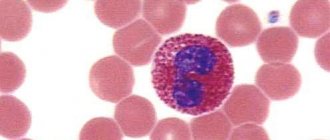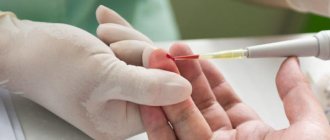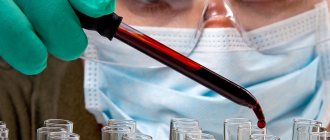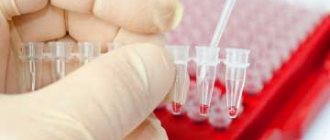The role of prothrombin in the body
Prothrombin is a glycoprotein that is produced in liver cells with the participation of vitamin K. The main role of prothrombin is participation in blood clotting: plasma coagulation factor II. The protein is inert in nature, activated only under the influence of coagulation factor XII (internal system) or when the endothelium is damaged (external mechanism of hemostasis). At a certain stage, prothrombin is involved in balancing the rheological properties of blood. In addition, prothrombin indirectly regulates the process of inflammation in the body.
The process of blood coagulation and inflammation proceed in parallel, in dynamics, with a predominance of one or the other, when the general condition of the patient requires it.
Indications for testing
Analysis for determining the prothrombin index of blood has many indications, both among diseases and specific problems:
- liver pathology;
- autoimmune processes in the body;
- preparation for surgery, postoperative rehabilitation;
- vitamin K or C deficiency;
- blood monitoring when taking medications (anticoagulants, antiplatelet agents) on an ongoing basis;
- pregnancy, when bleeding is predicted during childbirth or the postpartum period;
- pathology of the heart and blood vessels;
- varicose veins;
- atherosclerosis;
- blood diseases.
Reasons for increased prothrombin levels
An increase in the indicator may indicate the following diseases:
- Diseases of the gastrointestinal tract. With these pathologies, the patient has a malabsorption of nutrients and vitamins, which reduces the production of prothrombin.
- Dysbacteriosis. Violation of the intestinal microflora also leads to indigestion and deterioration of the body's functioning.
Reasons for increased prothrombin index
- Vitamin deficiencies accompanied by phylloquinone deficiency.
- Malignant tumors leading to depletion of the body.
- Anemia.
- Thrombohemorrhagic syndrome is a disorder of hemostasis, which is accompanied by the formation of blood clots in the vessels.
- Complex liver diseases.
- Pathologies of protein metabolism.
- Excess heparin in the patient's blood.
- Taking drugs with an anticoagulant effect: Heparin, Warfarin, Aspirin, etc.
- Genetic pathologies accompanied by insufficient production of prothrombin.
Aspirin
A reduced level of prothrombin poses a danger to human health, since even a minor injury in this case can lead to extensive blood loss. To prevent such complications, the patient is prescribed the following medications:
- Thrombin is a natural component of the blood coagulation system;
- Vikasol is a synthetic analogue of vitamin K;
- Ambien is a drug that has an antifibrinolytic effect.
Attention! The doctor selects the dosage and type of the drug based on the results of the coagulogram and the patient’s health condition. In most cases, the patient must first stop the underlying disease that led to increased bleeding.
Video - Why is PTI prescribed?
Pre-preparation and progress of the study
Blood diagnostics for coagulogram (PTI and other indicators of the coagulation system) are carried out in all laboratories of public or private clinics. The collection is always carried out from a vein. To ensure the reliability of the data, proper pre-preparation for analysis is necessary:
- blood is donated on an empty stomach, in the morning;
- on the eve of the study, refuse to drink alcohol or cigarettes;
- the use of medicinal herbs is excluded;
- coordinate with the doctor the intake of medications;
- warn about the use of hormonal contraceptives, the presence of allergies;
The time it takes to analyze and decrypt data does not exceed a day. The method of analysis for PTI is optical and chromogenic coagulometry. The bottom line is that a synthetic peptide (chromogenic compound) is added to a test tube with test blood, a reaction occurs with the coagulation factor, as a result of which the dye is released, and its amount can be measured photometrically, visually.
What determines the change in the index?
PTI its norm depends on the level of prothrombin in the blood. If the level is below normal, there is a risk of heavy bleeding. Hemorrhages in the brain and abdominal cavity are especially dangerous. The prothrombin index may be lowered for the following reasons:
- Lack of vitamin K.
- Liver diseases.
- Lack of fibrinogen.
- DIC syndrome.
- Excess heparin.
- Amyloidosis.
- Nephrotic syndrome.
- Pancreatitis.
- Oncology of the gallbladder.
- Leukemia.
- Taking strong medications.
An increase in PTI indicates accelerated blood clotting, which can cause the formation of blood clots that can block blood flow and lead to dangerous consequences. An increased prothrombin index can be caused by the following reasons:
- Genetic predisposition.
- High content of red blood cells.
- Oncological diseases.
- Lack of heparin.
- Pregnancy in the third trimester.
- Taking certain hormonal medications.
Today, several methods are used to determine PTI. This can negatively affect the diagnosis, because indicators may differ depending on the laboratory. A blood test for PTI should be deciphered only by the attending physician, taking into account all possible factors influencing the index.
Abroad, the biochemical blood test PTI has not been used for a long time; in developed countries, another study is carried out - INR. This analysis is more accurate and its indicators have standard forms of calculation. It is for this reason that in modern clinics, instead of IPT, in our country they also conduct an INR study.
Doctors pay special attention to the level of prothrombin in the blood of women carrying a child. Every pregnant woman should donate blood for IPT so that doctors can promptly identify possible abnormalities. If deviations from the norm are detected, expectant mothers are prescribed corrective drug therapy.
Unfortunately, many expectant mothers ignore doctors' orders to get tested. They believe that these indicators are completely unimportant for their health, since they feel good. However, statistics say otherwise. According to statistics, 10% of women who did not take a blood test for PTI, unfortunately, died during childbirth from sudden severe bleeding or from the rupture of a hidden blood clot.
Decoding
A blood test assessing PTI - prothrombin index - is a calculation of the ratio of plasma clotting time of a healthy person and the patient being examined. PTI is calculated as a percentage. When PTI is less than normal, there is a risk of bleeding. When PTI is greater than normal, there is a threat of thrombophlebitis or stroke.
In practice, several methods are used to determine plasma clotting time. More often than others, the Quick or INR method is used. IPT is considered a somewhat outdated type of examination, but is practiced everywhere, especially during the period of preparation for surgery and childbirth.
The most modern technique is INR. WHO experts call it a priority when monitoring treatment with indirect anticoagulants (vitamin K). This therapy is carried out for thrombophlebitis, thrombosis, pulmonary embolism, complications of heart attack, and coronary insufficiency.
INR analysis allows you to adjust the dose of drugs and monitor the effectiveness of therapy. INR is the international normalized ratio, a classic when one tube is used, which minimizes the accuracy of the diagnosis, but allows for rapid testing. The INR can be presented as a percentage or as a ratio. A range of 0.82 to 1.15 units (50 to 150%) is considered normal.
The essence of the Quick method is the same, the only difference is in the number of samples tested. Several plasma dilutions are compared, so the results are more accurate, but it also takes more time. The PTI norm according to Quick is in the range from 75 to 140%.
What determines the change in the index?
PTI its norm depends on the level of prothrombin in the blood. If the level is below normal, there is a risk of heavy bleeding. Hemorrhages in the brain and abdominal cavity are especially dangerous. The prothrombin index may be lowered for the following reasons:
- Lack of vitamin K.
- Liver diseases.
- Lack of fibrinogen.
- DIC syndrome.
- Excess heparin.
- Amyloidosis.
- Nephrotic syndrome.
- Pancreatitis.
- Oncology of the gallbladder.
- Leukemia.
- Taking strong medications.
An increase in PTI indicates accelerated blood clotting, which can cause the formation of blood clots that can block blood flow and lead to dangerous consequences. An increased prothrombin index can be caused by the following reasons:
- Genetic predisposition.
- High content of red blood cells.
- Oncological diseases.
- Lack of heparin.
- Pregnancy in the third trimester.
- Taking certain hormonal medications.
Today, several methods are used to determine PTI. This can negatively affect the diagnosis, because indicators may differ depending on the laboratory. A blood test for PTI should be deciphered only by the attending physician, taking into account all possible factors influencing the index.
Abroad, the biochemical blood test PTI has not been used for a long time; in developed countries, another study is carried out - INR. This analysis is more accurate and its indicators have standard forms of calculation. It is for this reason that in modern clinics, instead of IPT, in our country they also conduct an INR study.
Doctors pay special attention to the level of prothrombin in the blood of women carrying a child. Every pregnant woman should donate blood for IPT so that doctors can promptly identify possible abnormalities. If deviations from the norm are detected, expectant mothers are prescribed corrective drug therapy.
Unfortunately, many expectant mothers ignore doctors' orders to get tested. They believe that these indicators are completely unimportant for their health, since they feel good. However, statistics say otherwise. According to statistics, 10% of women who did not take a blood test for PTI, unfortunately, died during childbirth from sudden severe bleeding or from the rupture of a hidden blood clot.
Norms of prothrombin index by age
PTI norms have no gender differences and are correlated only by age and gestational age.
| Age | Norm in % |
| Newborns on the first day | 60-142 |
| 1 month | 60-120,5 |
| Up to 1 year | 55,5-100 |
| Up to 6 years | 69,9-150,5 |
| Up to 15 years | 50,5-145,5 |
| Under 18 years old | 55,5-150 |
| After 18 until the end of life | 70-140 |
Norms of IPT during pregnancy
During pregnancy, the upper limits of normal IPT increase due to hormonal changes and the need to stimulate blood flow to remove fetal waste products. PTI is considered, as a rule, according to Quick and ranges from 98 to 152%. Plus or minus, depending on the specific case.
Exceeding and decreasing the maximum permissible value of PTI must be considered as a pathology. Only after understanding the cause of the deviations can you either calm down or prescribe the appropriate correction.
During the entire period of pregnancy, the prothrombin index remains virtually unchanged.
What determines the change in the index?
PTI its norm depends on the level of prothrombin in the blood. If the level is below normal, there is a risk of heavy bleeding. Hemorrhages in the brain and abdominal cavity are especially dangerous. The prothrombin index may be lowered for the following reasons:
- Lack of vitamin K.
- Liver diseases.
- Lack of fibrinogen.
- DIC syndrome.
- Excess heparin.
- Amyloidosis.
- Nephrotic syndrome.
- Pancreatitis.
- Oncology of the gallbladder.
- Leukemia.
- Taking strong medications.
An increase in PTI indicates accelerated blood clotting, which can cause the formation of blood clots that can block blood flow and lead to dangerous consequences. An increased prothrombin index can be caused by the following reasons:
- Genetic predisposition.
- High content of red blood cells.
- Oncological diseases.
- Lack of heparin.
- Pregnancy in the third trimester.
- Taking certain hormonal medications.
Today, several methods are used to determine PTI. This can negatively affect the diagnosis, because indicators may differ depending on the laboratory. A blood test for PTI should be deciphered only by the attending physician, taking into account all possible factors influencing the index.
Abroad, the biochemical blood test PTI has not been used for a long time; in developed countries, another study is carried out - INR. This analysis is more accurate and its indicators have standard forms of calculation. It is for this reason that in modern clinics, instead of IPT, in our country they also conduct an INR study.
Doctors pay special attention to the level of prothrombin in the blood of women carrying a child. Every pregnant woman should donate blood for IPT so that doctors can promptly identify possible abnormalities. If deviations from the norm are detected, expectant mothers are prescribed corrective drug therapy.
Unfortunately, many expectant mothers ignore doctors' orders to get tested. They believe that these indicators are completely unimportant for their health, since they feel good. However, statistics say otherwise. According to statistics, 10% of women who did not take a blood test for PTI, unfortunately, died during childbirth from sudden severe bleeding or from the rupture of a hidden blood clot.
Reasons for the decline
The prothrombin index of INR normally has the lower limit of normal – 50%. PTI in the blood decreases as a result of: congenital anomalies associated with insufficient fibrin synthesis, coagulopathies, liver pathologies, intake of anticoagulants, salicylates, antiplatelet agents, thrombolytics, laxatives, nicotinic acid, immunosuppressants, hormones, anabolic steroids. Reduces PTI DIC syndrome.
A low prothrombin index is evidence of thin blood, its long clotting, and the risk of spontaneous bleeding.











